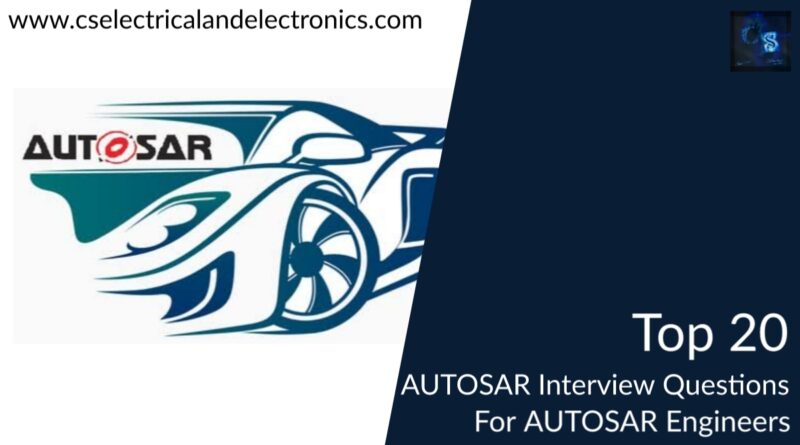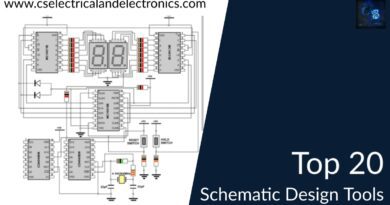Top 20 AUTOSAR Interview Questions For AUTOSAR Engineers
Hello guys, welcome back to our blog. Here in this article, we will discuss the top 20 AUTOSAR interview questions for AUTOSAR engineers or interview questions on AUTOSAR, and the questions with answers listed below are most commonly asked in interviews.
If you have any electrical, electronics, and computer science doubts, then ask questions. You can also catch me on Instagram – CS Electrical & Electronics.
Also, read:
- Products Manufactured By Texas Instruments In Various Domains
- Top 12 Microcontroller Manufacturing Companies In The World
- Products Manufactured By Infineon Technologies Company In Detail
Top 20 AUTOSAR Interview Questions
There are a lot of popular autosar questions but I’ve shortlisted down some of the major and mostly asked questions. Below is a list of best autosar interview questions and answers-
20) What is AUTOSAR?
Ans. The Automotive Open System Architecture (AUTOSAR) is an open software with standardized architecture which is developed by automobile manufacturers, suppliers, and many tool developers. The AUTOSAR enables the use of a component-based software design model for vehicular system design.
19) Name the full form of AUTOSAR.
Ans. AUTOSAR is known as Automatic Open System Architecture in its full form.
18) Explain AUTOSAR ECU in elaboration.
Ans. The AUTOSAR ECU is mainly used to establish and create open software with standardized software for the automotive electronic control units (the ECUs). Some of its goals are scalability to different vehicles and platform variants. The transferability of software and the consideration of the availability of safety requirements, the collaboration between partners, and sustainable use of natural resources during the whole product lifecycle. This type of architecture was introduced to promote the standardized software development process of Automotive Electronic Control Units.
17) List some uses of AUTOSAR.
Ans. AUTOSAR is mainly used for providing some intrinsic advantages to the associates to handle more complex electrical and electronic systems in a vehicle like a simple integration, a switch function within a complex ECU network to control the lifecycle of the whole product and its used microcontrollers which mainly target applications in automotive spaces which utilizes CAN, Flex Ray, Ethernet and many more. It is developed for using the least memory possible as a microcontroller has many constrained resources.
16) What’s ComStack?
Ans. The word ComStack stands for Communication Stack. In AUTOSAR it’s a layered architecture. Communication Stack provides vehicle network communication. It is also defined as a software stack that provides some communication services to the basic software modules and many applications Layer. In AUTOSAR it is a part of Basic Software.
There are three AUTOSAR Communication Stack modules-
- Services Layer
- MCAL
- ECU Abstraction Layer
15) Explain the architecture of AUTOSAR.
Ans. The architecture of AUTOSAR is a worldwide standard for basic software applications which mainly supports the development of global automotive software-based products. It also helps in the modification of products with reliable upgrades and reusability and scalability in software development.
14) Explain AUTOSAR MCAL.
Ans. The embedded software Microcontroller Abstraction Layer (MCAL) has direct access to all on-chips MCU modules as well as external devices as it’s itself a software module. It makes use of the most significant advantage that the layered structure of AUTOSAR compatible design enables.
13) Explain CAN with its purposes.
Ans. The CAN Network management of AUTOSAR is a hardware-independent legal tool that is used on CAN Network. It helps to coordinate between the basic transition and the sleep mode of the operation.
12) Give the function of RTE for AUTOSAR.
Ans. The AUTOSAR RTE is an acronym for Run-Time Environment which is located at the core of the AUTOSAR ECU. The infrastructure services it offers allow us to communicate between AUTOSAR modules. It generates the methods which help AUTOSAR components to access essential software files like OS or communication services.
11) What is an AUTOSAR blockset?
Ans. It is a block set that offers an AUTOSAR user the blocks for the development of classic platforms. The editor often defines the software components, Interfaces, and many data types to map them into pre-existing Simulink modules. It helps us to scale the components of the software to the ECUs.
10) What is an SWC?
Ans. It’s a file package with precompiled Flash Symbols and the ActionScript coding which allows the Flash developers to manage classes and many assets. They are often considered as a class library that cant is used directly from the flash player.
9) Why a CAN is having 120 ohms at each of its endings?
Ans. It helps to minimize the reflection of reference and reduces noise. It keeps the reflection away and problem free and the transmission line must always be terminated.
8) What CAN attribution is?
Ans. It’s nothing more than a node trying to take control over the CAN bus.
7) What is the CAN’s functioning speed?
Ans. At an optimum length(40m) the CAN function at a speed of 1Mbps, but if the cable is made longer the speed decreases drastically.
6) If the Master is sending 764 and the Slave is sending 744. Which one of them will get Arbitration, the master or the slave?
Ans. After MSB the nibble at the first position is the same, the arbitration of the message depends on which bit is more dominant. The lower the message identifier the higher the priority of the bit. As the master passes 7 the slave also passes 7.
5) What is the difference between the standard CAN and the extended CAN?
Ans. The foremost difference between the two structures is that the “CAN base frame” sustains a length of 11 bits for the identifier, and the “CAN extended frame” sustains a length of 29 bits for the identifier, created up of the 11-bit identifier (“base identifier”) and an 18-bit extension (“identifier extension”).
4) What is bit stuffing?
Ans. It is a non-return to zero protocol, an NRZ-5. It is a guarantee provided to the signal so that the receiver can easily resynchronize the transmitter with minor clock discrepancies. The NRZ-5 transmitter can utmost provide 5 bits with the same value. After these five bits, it inserts a stuff bit that has an opposite value.
3) Why is bit stuffing used?
Answer) Lengthy NRZ messages can cause a significant problem for the receiver:
- · Receivers can lose track when there are no edges which are known as clock drift.
- · The periodic edges often allow resynchronization between the sender and the receiver.
2) What are the functions of Logical Link Control in a CAN?
Ans. Logical Link Control (LLC):
- Notifications and filtering of messages with recovery management functions.
- Medium Access Control (MAC):
- It provides encapsulation and de-capsulation facility with error detection and control, stuffing and de-stuffing with serialization and de-serialization.
1) Throw some light on AUTOSAR Metamodel.
Ans. The UML2.0 is an AUTOSAR metamodel. It defines the language which describes the AUTOSAR artifacts. It mainly defines the attributes and their inter-relationships. The graphical illustration of the template is known as diagrams of classes.
This was about “Top 20 AUTOSAR Interview Questions“. I hope this article may help you all a lot. Thank you for reading.
Also, read:
- 100 + Electrical Engineering Projects For Students, Engineers
- 1000+ Electronics Projects For Engineers, Diploma, MTech Students
- 1000+ MATLAB Simulink Projects For MTech, Engineering Students
- 500+ Embedded System Projects For Engineer, Diploma, MTech, PhD
- 500+ Projects For Diploma Electrical, Electronics Student, Diploma Project
- 8051 Microcontroller Timers, TCON Register, TMOD Register
- Advancements In 3D Printing Technology And It’s Future
- Advancements In Power Electronics For Energy Efficiency
Author Profile
- Chetu
- Interest's ~ Engineering | Entrepreneurship | Politics | History | Travelling | Content Writing | Technology | Cooking
Latest entries
 All PostsApril 19, 2024What Is Vector CANoe Tool, Why It Is Used In The Automotive Industry
All PostsApril 19, 2024What Is Vector CANoe Tool, Why It Is Used In The Automotive Industry All PostsApril 13, 2024What Is TCM, Transmission Control Module, Working, Purpose,
All PostsApril 13, 2024What Is TCM, Transmission Control Module, Working, Purpose, All PostsApril 12, 2024Top 100 HiL hardware in loop Interview Questions With Answers For Engineers
All PostsApril 12, 2024Top 100 HiL hardware in loop Interview Questions With Answers For Engineers All PostsMarch 22, 2024Driver Monitoring Systems In Vehicles, Working, Driver Sleepy Alert
All PostsMarch 22, 2024Driver Monitoring Systems In Vehicles, Working, Driver Sleepy Alert








